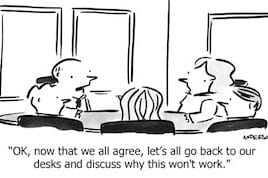September 11, 2016
The Dos and Don’ts of Effective Meeting Facilitation
By Chuck Doran and Stephanie Bailey

Meetings are an integral fixture of every organization, and yet, they do not have the best reputation. In a survey conducted by Salary.com, meetings are the “number one productivity killer.” Even worse news? A separate survey indicated that over half of the participants would rather do “any unpleasant activity” (even go to the DMV) than attend a status meeting, and employees spend nearly nine hours of every work week preparing for or sitting in meetings. The CEO of Mattel said his company lacked an “innovative culture” and finds bad meetings partially responsible. Al Pittampalli, author and “meeting culture” expert, calls ineffective meetings “weapons of mass interruption.”
Despite the fact that poorly-run meetings have become the laughing stock for cartoons like Dilbert and TV shows like “The Office,” you can reverse this trend by implementing the following plan to ensure that your next meeting isn’t a dud.
First, it’s crucial to have a working defintion of what an effective meeting looks like. MWI defines an effective meeting as “a collaborative process involving a defined group of people reaching their stated purpose.”
To achieve this, we will break the definition down to the “three P’s”: purpose, people, process.
Purpose
Before arranging a meeting, determine why you are calling the meeting in the first place.
- DO complete the sentence, “If our meeting is successful, we will have accomplished our goal of…”
- DON’T have the meeting if you’re having a hard time naming the objective.

People
The next element is deciding who needs to attend the meeting.
- DO identify the following roles:
- Who will facilitate? The facilitator should be able to remain objective and guide the group in a constructive way.
- Who will keep time?
- Who will take notes?
- Who will provide feedback to the facilitator after the meeting?
- DO ask for input about who should be at the meeting. It’s important to have the right people in order to provide perspective, share expertise and make and implement decisions.
- DO inform participants why they have been asked to attend the meeting. This way they can come prepared to participate fully and add value to the discussion.

Process
The process breaks down into three parts – preparation, meeting facilitation, and follow-up.
Preparation
- DO develop an agenda that reflects the objective(s) you wish to achieve. What activities or discussions will allow you to have the desired outcome? Each of the discussion points should have a time estimate.
- DO remain fluid with the agenda if it looks like participants are making progress outside of the time parameters.
- DO send the agenda to all participants prior to the meeting and ask for feedback from the group in advance of the meeting.
- DO be deliberate when choosing the time, date, and location of the meeting. When is your team most focused and cohesive? It might be convenient for you to have the meeting Friday at 4p.m., and other participants may not be as excited.
- DO get creative and appropriately utilize the meeting space. Every meeting does not have to be theater style seating; some meetings will thrive with participants around a conference table and others you may want to break into groups during the meeting.
- DON’T come unprepared! Know what materials you will need for the meeting and test any and all technology before the start.
- DON’T surprise your participants with new rules. Will technology be allowed at the meeting? Weigh both sides of the coin carefully – allowing laptops, phones, and tablets will mean some participants might ignore the content of the meeting while banning them could mean that others won’t take notes.
Meeting Facilitation
- DO be sure to welcome all participants and decide whether an icebreaker will be necessary.
- DO define the objectives at the beginning of the meeting with the group. Allow the participants to visualize success – what do they need to do to get there? This step reassures participants that time will not be wasted and that there is a tangible goal in mind.
- DO review the agenda and acknowledge any changes that may have been made. By respecting the agenda and its time recommendations, you are respecting the group.
- DO make sure to ask for input from all participants and also ensure that one participant does not dominate the conversation. Ask participants to “Step Up or Step Back”. If they tend to let others do the talking during a meeting, perhaps they will consider stepping up; or, if they recognize that they dominate the conversation, hopefully they will step back and let others be heard.
Follow-up
- DO reserve 10 to 15 minutes at the end to check-in with participants. Were the objectives achieved? If not, why not? What are the next steps?
- DO clarify who took notes and kept time and check-in that the minutes will be sent to everyone present and necessary in a timely manner. What will be done between this meeting and the next meeting? What can the facilitator do differently next time?
Some of these tips will seem rather straightforward or obvious, and many of them may be difficult to apply in a practical way. Continue to practice these skills, ask a trusted colleague to provide feedback after your meetings, network with people you know are great facilitators, and consider bringing in an outside facilitator if running the meeting will compromise your ability (or need) to participate.
For more information, contact Chuck Doran, MWI’s Executive Director, at 617-895-4026 or cdoran@mwi.org.


